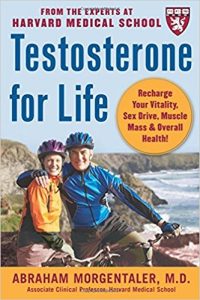DHEA
Description
Dehydroepiandrosterone (DHEA) is a steroid hormone produced in the adrenal glands, gonads (testes and ovaries), and brain.1 DHEA is often referred to as the “mother of all hormones” because it is the building block from which both male and female hormones are produced. It is synthesized in the adrenal glands, brain, and gonads, and it is locally metabolized into other steroid hormones including androstenedione, testosterone, and 17-B-estradiol (E2).1 DHEA is absorbed from the small intestine and transported to the liver to be metabolized and distributed to the various tissues where metabolites are synthesized. DHEA production declines in your mid-thirties to forties, leading to a deficiency that can make you feel mentally and physically exhausted. Exhaustion and stress are related to an increase in cortisol levels2 and DHEA’s role in countering cortisol levels is often overlooked.3,4 Cortisol is necessary for many important functions and is related to a normal stress response. When cortisol stays too high for too long, it becomes dangerous for those tissues that respond to cortisol.5 DHEA can help to bring cortisol back into balance.6 High sustained cortisol levels are known to be associated with many stress-related conditions. Given the high levels of stress everyone seems to deal with these days, it would be wise for adults of both genders to monitor their DHEA levels. Low DHEA levels can also lead to weakened immunity and increased inflammation.7
Benefits of DHEA Replacement
- Improves function of the immune system6,8-11
- Cognitive enhancement4,9,12
- Increases energy
- Reduces body fat and cholesterol13
- Increases insulin sensitivity14
- Potent antioxidant
- Slows some of the effects of aging in women15
- Improves mood4,16
- Supports healthy bones and calcium absorption in men17,18
Side Effects
DHEA should not be used by individuals with a history of prostate, uterine, ovarian or breast cancer. Diabetics should carefully monitor blood sugar levels, as DHEA may alter glucose regulation. Use with caution in individuals with hepatic dysfunction or hypertension.
Consult your physician before supplementing with DHEA if you are taking these medications: 4-androstenedione, 4-androstenediol, 5-androstenedione, 19-4-norandrostenedione and 19-5-norandrostenediol, testosterone replacement therapy, or estrogen replacement therapy (Premarin, Estrace, etc.).
Anti-depressants: fluoxetine (Prozac), paroxetine (Paxil), sertraline (Zoloft), citalopram (Celexa).
Medicines for seizures, certain mental disorders or pain: For example, fluphenazine (Prolixin), thorazine (Stelazine), thioridazine (Mellaril), clozapine (Clozaril), haloperidol (Haldol), risperidone (Risperdal), lithium (Lithonate, Lithobid), loxapine (Loxitane), olanzapine (Zyprexa), quetiapine (Seroquel), carbamazepine (Tegretol), valproic acid (Depakote).
Administration
DHEA is usually taken orally in capsule form; however, creams or gels are also effective. DHEA can be obtained over the counter or through a compounding pharmacy. Pharmacies that compound DHEA produce a micronized, slow-release form for a more consistent serum level. Hormones obtained through a pharmacy are usually of a higher pharmaceutical grade than over the counter.
References
- Shah AH, et al. DHEA and estradiol levels in brain, gonads, adrenal glands, and plasma of developing male and female European starlings. J Comp Physiol A Neuroethol Sens Neural Behav Physiol. 2011 Oct;197(10):949-58.
- Wolfram M, et al. Emotional exhaustion and overcommitment to work are differentially associated with hypothalamus-pituitary-adrenal (HPA) axis responses to a low-dose ACTH1-24 (Synacthen) and dexamethasone-CRH test in healthy school teachers. Stress. 2013 Jan;16(1):54-64.
- Bauer ME, et al. Psychoneuroendocrine interventions aimed at attenuating immunosenescence: a review. Biogerontology. 2013 Feb;14(1):9-20.
- Alhaj HA, Massey AE, McAllister-Williams RH. Effects of DHEA administration on
episodic memory, cortisol and mood in healthy young men: a double-blind,
placebo-controlled study. Psychopharmacology (Berl). 2006 Nov;188(4):541-51. - Cohen S, et al. Chronic stress, glucocorticoid receptor resistance, inflammation, and disease risk. Proc Natl Acad Sci USA. 2012 Apr 17;109(16):5995-9.
- Buford TW, Willoughby DS. Impact of DHEA(S) and cortisol on immune function
in aging: a brief review. Appl Physiol Nutr Metab. 2008 Jun;33(3):429-33. - Huerta-García E, et al. Dehydroepiandrosterone protects endothelial cells against
inflammatory events induced by urban particulate matter and titanium dioxide
nanoparticles. Biomed Res Int. Epub 2013 Jan 14. PubMed PMID: 23484113. - Szkróbka W, Krysiak R, Okopień B. [Adrenopause]. Pol Merkur Lekarski. 2008
Jul;25(145):77-82. - Davis, SR, Shah, SM, et al. Dehydroepiandrosterone sulfate levels are associated with more favorable cognitive function in women. J Clin Endocrinol Metab. 2008 Mar; 93(3):801-808.
- Maes, M, Mihaylova, I, De Ruyter, M. Decreased dehydroepiandrosterone sulfate but normal insulin-like growth factor in chronic fatigue syndrome (CFS): relevance for the inflammatory response in CFS. Neuro Endocrinol Lett. 2005 Oct; 26(5):487-492.
- Khorram, et al. Activation of immune function by dehydroepiandrosterone (DHEA) in age- advanced men. J Gerontol A Biol Sci Med Sci. 1997 Jan; 52(1):M1-7.
- Hampl R, Stárka L. [Dehydroepiandrosterone, “the youth hormone”, in the light
of recent findings]. Cas Lek Cesk. 1998 Jan 12;137(1):8-12. - Villareal, DT, Holloszy, JO. Effect of DHEA on abdominal fat and insulin action in elderly women and men: a randomized controlled trial. JAMA. 2004 Nov 10;292(18):2243-8.
- DHEA. Monograph. Altern Med Rev. 2001 Jun;6(3):314-8.
- Genazzani AR, et al. Long-term low-dose oral administration of dehydroepiandrosterone modulates adrenal response to adrenocorticotropic hormone in early and late postmenopausal women. Gynecol Endocrinol. 2006 Nov;22(11):627-35.
- Schmidt PJ, et al. Dehydroepiandrosterone monotherapy in midlife-onset major and minor depression. Arch Gen Psychiatry. 2005 Feb; 62(2):154-162.
- Sun Y, et al. Treatment of osteoporosis in men using dehydroepiandrosterone sulfate.Chin Med J (Engl). 2002 Mar;115(3):402-4.
- Chen RY, et al. Relationship between calcium absorption and plasma dehydroepiandrosterone sulphate (DHEAS) in healthy males. Clin Endocrinol (Oxf). 2008 Dec;69(6):864-9.
